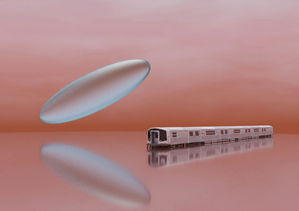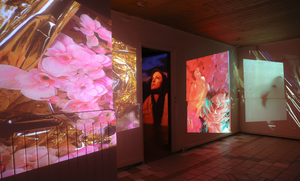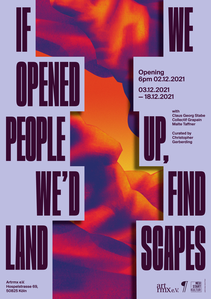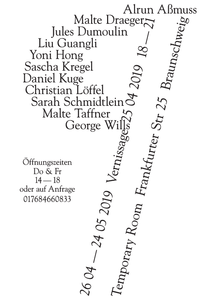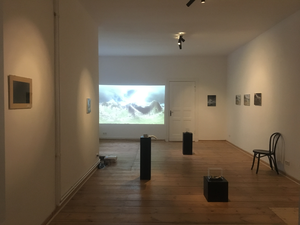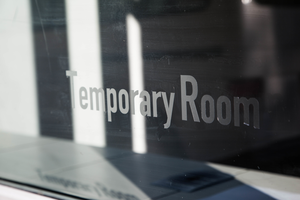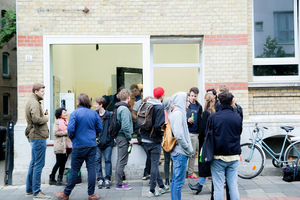Projekte
Mystery Train _ Yoni Hong
Es ist keine lange Reise, die angegangen werden muss, um die alte Tankstelle zu erreichen. Aber auch keine besonders kurze. Immer weiter geradeaus, etwas abseits, zwei Brücken und ein starker Wind von rechts. Eine Wendeltreppe, das direkte Rauschen der Autobahn, getaggte Garagentüren und ein Neonlicht mit der Aufschrift “Mystery Train” lassen einen Wissen, dass wir angekommen sind.
Angekommen sind wir dennoch nicht, es ist nur der Anfang einer Reise, die kein Ende in Sicht hat. Es bleibt uns überlassen, ob wir draufspringen oder abspringen wollen.
Der Mystery Train rauscht weiterhin durch uns hindurch oder an uns vorbei.
Aber lasst uns für einen Augenblick zum Empirischen an diesen Ort zurückkehren, wo der aufgebrochene Asphalt und der leichte Dieselmotorgeruch uns ein Gefühl des deja-vu verleihen.
Es ist ein Ort der Anonymität, Einsamkeit und Entwurzelung - ein klassischer Transit-Ort.
Ein Nicht-Ort1, das ist nach Marc Augé ein Ort, an dem uns der Mangel an metaphysischen Qualitäten sofort auffällt – das seiner Identität, Relation und Geschichte. An diesem scheinbaren non-lieu können wir diese Eigenschaften jedoch wiederfinden. Die Tankstelle hat genauso viel Identität und Geschichte wie ein verrauchtes Motel am Rande der Stadt. Ausgerechnet an diesen Ort nimmt uns Yoni Hong auf eine Reise mit. Sie versetzt uns ein Stück weit nach Memphis, verwandelt die Tankstelle zu einem Portal, in das wir hinein schlendern können, ohne dabei geführt zu werden. Hong verwandelt den Ort, macht ihn nichtig. Sie raubt uns die Orientierung und vereinnahmt es uns mit Träumen, Welten und schwebenden formen.
Yoni Hong ist in Seoul geboren und hat in Ihrer Kindheit oft ihren Wohnsitz gewechselt, wodurch sie viele Plätze neu erleben und entdecken durfte.
Ihre Fantasie und Einfühlvermögen verleihen Ihr eine Sensibilität für Materialitäten und Formen, die sie schöpferisch in Videoarbeiten oder Installationen umsetzt. Ihr Ansatz gleicht dem von ArchitektInnen oder VideospieldesignerInnen. Ihre stärkste Fähigkeit liegt darin Räumen, Licht und Objekten eine Atmosphäre zu verleihen.
Was wird hier als Atmosphäre bezeichnet? Atmosphäre ist das Erste, was uns beim betreten eines Raumes trifft, sofortige Berührung, sofortige Ablehnung. Atmosphäre spricht unsere emotionale Wahrnehmung an2. Das erste Gefühl, das wir bekommen, die erste Erinnerung, die wir beim betreten eines uns unbekannten Raumes erhalten ist auf Atmosphäre zurückzuführen. Yoni Hong besitzt diese emotionale Wahrnehmung und sie verbindet wie eine Ingenieurin, Architektin oder Filmemacherin alle Elemente-Form, Material, Musik, Bewegung, Komposition, Text und alles, was man braucht, um den Träumen am nähesten zu kommen.
So wie JMW Turner 1844 zu John Ruskin sagte, kann auch Yoni Hong behaupten.
Atmosphere is my Style 3 _________________________________________________________
1(Augé, M. (2016). Non-lieux: Introduction à une anthropologie de la surmodernité. Éditions du Seuil.)
2 Zumthor, P. (2004). In Peter Zumthor - Atmosphären: Architektonische Umgebungen. die dinge um mich herum.
3Zumthor, P. (2004). In Peter Zumthor - Atmosphären: Architektonische Umgebungen. die dinge um mich herum.
The Holy Petrol Station of Imaginary Penitents _ Krzysztof Honowski
Zosimas
by Maggie Siebert
She’s digging through hard soil at the base of a modest tree. She’s pulling clumps of mushrooms from the earth and placing them in her mouth with her thumb and forefinger. Deliberate. Her flesh sits against her bones as if vacuum sealed. Her hair is a miasma of knots. She is naked and shuddering in the cold night air.
Beaten to shreds by sunlight, she traverses the public park where I have sometimes seen her in relative darkness. People amble down the path several yards ahead of me, but I am the only one who sees her. No one is used to seeing skin like hers anymore. She is scaled like a lizard, covered in big, dry, hardened patches which crack and reform and no longer shed. There is dirt caught between the layers. She could be aged like a tree if cut in half.
I do not yet know if she can see me. In truth, I am still uncertain of her humanity. I begin to approach her as if I’m trying not to startle a cat. After my first steps, she turns to face me, slow and deliberate. I see that she is, despite appearances, more like me than something else. I hold out my hand, and when she does not come to it I ask if she needs any help.
For a time she is silent. Then, in warbling but nevertheless clear tones, she says: “Will you bring me my coat?”
And before me is a coat where there was once only grass.
I pick it up and hand it to her. She pulls it around her shoulders and slumps backward onto the ground. I stand there unsure of what to do next until she punches the ground beside her once, hard, and gestures at me to sit with her open palm.
“I want to tell you about something that happened to me,” she says. So I sit and listen.
–
Many years ago she awoke floating atop a sea of people. They stood beneath her and guided her body with their hands. None of them were clothed. When she looked out to see where the ocean of bodies might end, she could see only the tops of heads far into the horizon. She panicked and tried to stand and run across them, but she immediately lost her balance. When she tried to pull herself forward, as if swimming, the people below flipped her onto her back. Paralyzed by fear, she allowed herself to float for a while, letting the hands carry her where they wanted. But soon bodies began to rise from the crowd, and she was no longer the only one lost at sea. She rejoiced, and the hands directed her closer to the new castaways, whom she embraced. And when she did she felt herself grow slick and it was the natural thing to pull them
inside her, or to insert herself inside them. As she did, more bodies rose to join them and the hands beneath pushed them faster and faster. And soon she could not tell herself from others. It was as if her tongue was many, her hands ever multiplying, a hot, pulsating, oppressive and sweet sensation flooding her senses until it all blended into skin: an endless, rolling wall, wet like the inside of a cheek in some places but covered in papules and moles and hair in others. She could not say how long she persisted in this state, whether weeks or decades. But after a time, perception itself started to give way. As her vision was about to give way to nothing but blinding white heat, she hit the ground hard.
–
I sit with her for a long time after she finishes her story. Just a little beyond us, the halogen lights illuminating a walkway flick off. The park is closed for the night. I wonder where she will sleep but decide I don’t actually care to know.
I ask her why she wanted to tell me all this.
She looks at the dirt before her and picks something out of her teeth. I wonder if she will speak at all. And then she looks at me and says, not out loud, but just in my head:
“I wanted someone to know that things are better for me now.”
If we opened people up, we'd find landscapes
The sacred in a faulty printer
Some centuries ago, although not that many, the reality of an ordinary person was that of being in two places at once. The pre-industrial individual lived the reality of their life of work, as well as the reality of their belief in an active exchange with the divine. Here is an exhibition about how our lived reality has, in much the same way, crossed over with the digital. While they are not quite on a mystical quest, in the work of Collectif Grapain, Claus Georg Stabe, and Malte Taffner, we find a particular sensitivity for process. Brought together here are positions that contemplate what it takes to arrive somewhere in this world between the body and the machine, and what at times can go wrong along the way.
This meditation on the fallible is most explicit in the work of Claus Georg Stabe, where intricate penwork accumulates line after line into the illusion of a faulty machine photocopying memories of the sublime. Stabe’s dense Moiré effects, interrupted by ink drips, seem to contend with the desire to escape from form, into an expression of devotion to the trace that perception leaves on inner experience.1
Devotion in Stabe’s work is also to honour the shadow of the memory, to know how much infrastructure is necessary to begin to express the act of perception. Similarly Collectif Grapain seek to establish monuments for the hidden mess of the sleek contemporary. Instead of allowing the slowly obsolete ethernet cable to clog up another landfill, feeding the earth with microplastics, the artists compose contorted agglomerations of these cables into almost organic sculptural forms. This act suggests both a tribute to Moore’s law2 as well as a warning shot. If we opened people up we would find the dreams of previous generations in the shape of the metal remains of the balls of all their computer mice.
If we opened people up, we‘d find landscapes posits the possibility of an act of transparency, a baring: Instead of perceiving landscapes of desire at a distance,3 we can or perhaps even already do embody them.4 It is not in your head, but in your hands: make it happen. In this show by the curator Christopher Gerberding we find the dichotomy between verifiable knowledge and its application re-articulated in the disquieting way in which we have come to encounter it with unspeakable regularity throughout the pandemic.5 We cannot know what would happen if we opened people up, as they would be dead, and so no longer people. We can only trust in the potential of this poetic assertion, backed up by the work of Collectif Grapain, Claus Georg Stabe, and Malte Taffner. We cannot cure our doubt through edict, people would just see that as a challenge. Things are unpredictable, thumbs are opposable, the macro view varies appreciably from the microcosm. Each individual is a high-wire act, balancing between their privilege and the all consuming perfectionism of a data driven society. I think therefore I am. I know therefore I am confused. Oh God...6
Of the three artists in this show, Malte Taffner seems the least interested in what a landscape could come to mean, and looks rather at what a landscape actually is. Taffner’s work engineers natural processes and seeks to put them in relation to the planned zones of metaphorical thinking that make up the sites of the artworld. In this way his and Gerberding’s entreaties meet as complementary forces, whereby Taffner suggests that if people had the time to find landscapes, maybe they would open up.
Krzysztof Honowski, November 2021
1 See Jack Goldstein’s pursuit of the trace in his lecture at the Art Center College of Design, Pasadena, California, October 14, 1992
2 A 1965 observation by Intel’s Gordon Moore which accounts for why technology just keeps getting better and better.
3 pace the Ecstatic Landscapes of Werner Herzog
4 And one quickly comes to the relieving realisation that Christopher Gerberding is also suggesting that you cannot shell a human like a walnut without being a psychopath.
5 And who are we anyway? The people? The polis? The audience in collusion with curator? Here “we” allows us to perceive a togetherness, or a directness that we have only newly come to appreciate through it’s pandemic-induced denial.
6 Or perhaps “The word God”, which is the devotional authority that preoccupies Georges Bataille.
